Welcome to the first part of my Dredge primer! Today, I’ll talk about maindeck card choices – what are the main goals of the deck, why is it built this way, not another, and what are the basic interaction between the cards.
If you want to find more Dredge content, including a detailed sideboard guide, check out this link.
If you are not familiar with currently played Dredge lists, you can find an example here.
Introduction
Dredge is an aggro-combo deck that abuses the mechanic ‘Dredge’ to create card and tempo advantage. The more cards we flip from our library to the graveyard, the more threats we can present, so in practice, the main goal is to mill as many cards as possible. Deck has two main ways to pressure the opponent. The first one is aggro with recursive creatures – Prized Amalgam, Silversmote Ghoul, Narcomoeba, and Ox of Agonas. The second one is Burn in the form of Creeping Chill and Conflagrate (assuming you play it). In tempo games, Dredge tries to set up a big board quickly and win before the opponent can deal with every threat or execute their game-winning combo. It doesn’t matter that our creatures aren’t the most powerful on their own. What matters is that you often go so wide that the opponent won’t be able to deal with everything on time. In some match ups Dredge can also act as a value, card advantage oriented strategy, which can overwhelm the opponent with generated card advantage. It’s also possible to act as a control deck. For example, it works quite well in some creature matchups thanks to Conflagrate, Darkblast, sideboard creature removal, and spam of blockers. This type of play is less and less seen though.
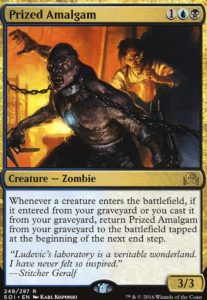
This incredible flexibility gives Dredge players a unique opportunity to constantly adapt to what they are up against. But it’s also a real challenge to play the deck correctly. Literally, your every play matters. Timing, decision-making process based on flipped cards, fighting through grave hate cards, etc. It took me years to master that archetype. And thanks to my guides, I hope this process will be easier for you.
Dredge in 2022 vs old builds. Why the change was needed?
It all started in 2016 when Prized Amalgam and Cathartic Reunion got printed. Dredge was a very different deck then. Life from the Loam was a centrepiece of the archetype – it helped enable huge Conflagrate shots as well as endless Bloodghasts triggers. This version was very flexible and could act as a tempo, midrange, or even a control deck, all with chances for a combo draw. The deck was so busted compared to the rest of the metagame that Wizards had to nerf it a bit. They decided to ban Golgari Grave-Troll.
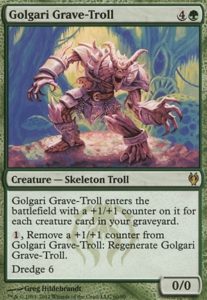
The deck survived and was still playable thanks to the addition of Golgari Thug. But it wasn’t as stable and fast, so it was slowly being outclassed by other, new strategies. In 2018, I was even close to abandoning the deck, but the printing of Creeping Chill got the power boost Dredge needed. Later, we got Hogaak, Arisen Necropolis, but it got banned two months later, alongside Faithless Looting. And that was the end of major changes for the archetype back then. Sure, we got Ox of Agonas in January 2020, but compared to what the rest of the format got (Uro, Titan of Nature’s Wrath for example), it wasn’t that spectacular. Still, the card let Dredge survive the rise of the power level of the average Modern deck, even if it worked horribly with Life from the Loam + Conflagrate engine. But after the biggest jump in format’s power level – the release of Modern Horizons 2 – Ox alone wasn’t enough – other decks were faster, more stable, and less vulnerable to hate. Graveyard hate cards were overpowered compared to what graveyard decks could present. It was either for zero mana (like Endurance), or the game ended when it entered the battlefield (Dauthi Voidwalker or Sanctifier En-Vec are good examples of that). On the other hand, the traditional build of Dredge was still quite slow, fragile to the hate and had a higher fail rate than other options available in the format. There simply weren’t enough arguments to play it in its current form. When old ideas were no longer good enough, the only hope for the archetype was to be rebuilt from scratch. The flexibility of game plans turned out to be not impactful enough to rely on it. Because of how the deck works, we couldn’t make the deck much more stable – the variance of what we flip in the top twenty cards of the library will always lead to some broken starts and fail rates as well. The only thing that could be upgraded was how fast we can present meaningful board states. That’s why the current build of Dredge is focused on presenting as much power on turns two and three as possible. The deck relies more on ‘draw three’ effects and a curve: turn one any enabler, turn two Cathartic Reunion//Thrilling Discover and turn three escaping Ox of Agonas. During this process, we try to flip as many payoff creatures that can return to the battlefield on the same turn we cast a ‘draw three’ effect. Narcomoeba and Prized Amalgam were already there. The newest addition was Silversmote Ghoul, thanks to its synergy with Creeping Chill. Bloodghast got cut because it can’t return to the battlefield after we resolved a turn two Reunion. Also, it required lands to trigger it and without Life from the Loam, it’s hard to accomplish. And speaking of Loam – it’s not worth spending a turn on future land drops when the alternative is setting up creatures to pressure the opponent’s life total a turn faster. The manabase also was rebuilt to better support ambitious mana requirements. More details below.
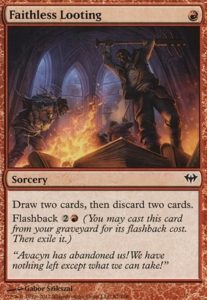
Why you should play Dredge?
If you want to play Dredge because you think it’s the best deck in the format, I have bad news for you. It’s not 2016 anymore when doing any type of broken stuff was enough to win tournaments. Now everyone does something at least a bit unfair to punish opponents’ worse draws. Another problem is that grave hate options are much better compared to graveyard threats, at least compared to older times. That’s why if Dredge is close to becoming a tier one deck, it will instantly be hated out. Our fate is to be a solid tier two strategy that happens to be good when there isn’t that much graveyard hate and there are enough good matchups around.
Even if Dredge will probably never be a tier one again, it offers a unique experience and play patterns that can’t be repeated by any other deck in the format. Its high-variance nature is also something that can be seen as a reason to play the deck. It mulligans quite well and it really doesn’t matter if you start with seven or five cards in hand. As a result, you’ll have a lot of looks for your broken opening. And when it happens, some games will end after you turn one enabler into turn two Cathartic Reunion or Ox of Agonas into a lot of power. This ability to overwhelm the opponent lets Dredge win some percentages of games even vs the worst matchups.
Dredge’s best and worst matchups.
In my opinion, Dredge shouldn’t be considered a deck that you should play all the time. It’s better to use it as a ‘solution’ to certain metagames. My rule of thumb is if there are a lot of decks that fold to three 3/X creatures on turn two, Dredge is a good choice. Extra bonus points if Darkblast can kill their one drops or Creeping Chills are too much for the opponent to handle. So for instance, Dredge is a good choice if your metagame is flooded with Murktide, Grixis Shadow or Burn. It’s also fine vs slower decks like UW Control and 4c Omnath. On the other hand, I would avoid it if there are more combo-oriented decks like Hammer, Amulet, Underworld Breach, or if players opt to play maindeckable grave hate. A good example would be RB Scam which would be a good matchup if not their three or four copies of Dauthi Voidwalker in the maindeck.
Analysis card by card
I separated cards in the maindeck into four sections: dredgers, enablers, payoff and lands.
Dredgers
The archetype is all about… dredgers. It’s the most efficient way to selfmill and the more cards we flip in early turns of the game, the bigger the chances for finding the duo of Narcomoeba + Prized Amalgam or Silversmote Ghoul + Creeping Chill are. The biggest power of Dredge is it can chain dredgers (the first dredge card can find another and so on), so if everything goes right, we never have to naturally draw cards. This means that we both decrease the chances to draw our payoff cards to the hand and increase to flip them to the graveyard.
Stinkweed Imp
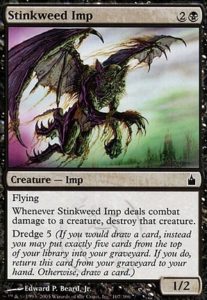
The best Dredger we have left in the format. Outside being the biggest Dredge number, it’s also a relevant creature to cast. A repetitive deathtouch threat can stop big boards all by itself. And flying lets us win trash wars during board stalls. Always play four copies, never side it out.
Golgari Thug
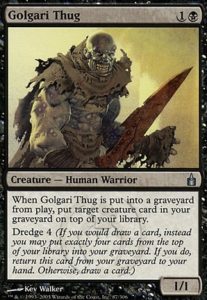
It’s a necessary evil since Golgari Grave-Troll was banned. Most of the time it will be a ‘Dredge four’ card. But don’t forget it’s a creature with relevant ability. Bunch of situations and tricks:
– The most frequent use of the trigger is to put Narcomoeba from the graveyard back to the top of the library. It’s useful when you are in chump block mode, to present two creatures every turn (Narco and hardcasted Thug). It’s also good vs control decks with sweepers, so you’ll have guaranteed Narco next turn (or even the same turn with an instant speed selfmill or dredge action available) to trigger Amalgams. In mid-game vs soft hate, sometimes Ox of Agonas is a relevant target too.
– You can respond to the Thug’s trigger. The most iconic use was targeting Bloodghast and in response using fetchland to return it to the battlefield and fizzle Thug’s trigger. It’s not that relevant nowadays though.
– Remember that Thug’s trigger is not a ‘may ability’. So don’t cast it if your dredge chain is broken and you want to restore it while not having any other creature in a graveyard to target. Without any, Thug after the death will target himself and you’ll draw a blank instead of a possible enabler.
Darkblast

On the surface, this card looks very simple. -1/-1 and a trade one for one before the start of our fireworks is a great tempo swing. It gives us more turn one plays – something the deck desperately needs. Most of the time it’s used vs decks with X/1 creatures: Ragavan, Nimble Pilferer, Dragon’s Rage Channeler, Esper Sentinel, mana dorks, a Dwarf token, Inkmoth Nexus, etc. But that’s only the beginning! It can also kill creatures post-combat after our threats have dealt combat damage. The most common line is dealing with X/4 creatures after they block our three power guys. Omnath, Locus of Creation, Endurance, Yawgmoth, Thran Physician, a Rhino token from Crashing Footfalls, Scion of Draco, Urza, Lord High Artificer, Dryad of the Ilysian Grove etc. X/2 creatures can also be affected if you have Golgari Thug or Narcomoeba. It’s a fine way to kill Solitude for example, before they untap and gain even more life from Lifelink. Another way to kill X/2 creatures is to cast Darkblast on your upkeep, Dredge it and cast it again. Darkblast can also kill our own creatures. Killing Golgari Thug to put Narco to the top to trigger it in the next Dredge or to avoid losing to decking also can happen from time to time. It can also ‘protect’ Silversmote Ghoul from exile effects. Darkblast can also deny lifelink – kill your blocked/blocking X/1 creature after blocks, before the damage.
Life from the Loam

It’s more like an honorable mention than a real card in the current Dredge build. Dakblast won a competition for a ‘Dredge three’ card of choice. Casting Loam nowadays feels too slow and not impactful enough. It’s nearly always better to cast a Reunion effect or to escape the Ox. Still, maybe one day we’ll return to the build based on this engine.
Enablers
We know that keeping the Dredge chain active is important in Dredge. But we need to start the engine somehow. To make it work, we have enablers. These are the most efficient ways to put Dredgers in the graveyard and redraw as many cards as possible for the lowest mana cost. Remember – our goal is to escape Ox of Agonas on turn three. This means that a Reunion effect on turn two should be enough to set it up – it’s three dredged cards plus another one from a natural draw. Having extra Reunion effects in hand is not a bad thing, but there’s a chance they won’t be used because they will be discarded thanks to Ox of Agonas – if you have the option of casting yet another Reunion or Reunion on legs that will trigger Amalgams, it’s very likely that getting a guaranteed 5/3 on board will be better. That’s why we also want to use enablers on turn one, just to do something with cards in hand. Binning a dredger before the draw step on turn two gives you another opportunity to flip more stuff. Your best hands will contain at least two lands, something to cast on turn one and a Reunion effect.
Tome Scour
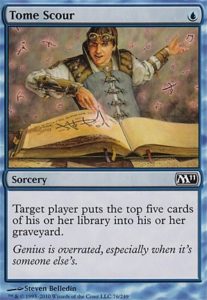
It’s the best turn one play in goldfish scenarios. I like to call it a ‘Stinkweed Imp on a stick’. It’s simple and doesn’t require any other card to do its thing. It’s also a good way to find a dredger – if you kept a Scour + Reunion hand, mill five gives you a 79% of chance to flip a dredger if you play twelve copies, 74,5% if eleven. It’s also the longest mill on a one mana effect, so it also increases chances of getting one of the payoff duo we want to collect: Narcomoeba + Prized Amalgam or Silversmote Ghoul + Creeping Chill. Tome Scour will give you six cards in the graveyard after turn one, so if you were lucky enough to flip Stinkweed Imp or Golgari Thug and unlucky enough to not get a lot of payoff cards, there’s a chance for escaping Ox of Agonas on turn two. It’s easily the most powerful effect on turn one in goldfish scenarios. Why is it not played as a four off? Unlike Otherworldly Gaze or Reunion effects, Tome Scour does only one thing and it won’t help you when something goes wrong. For example, if you don’t have a second land, you want to discard something from hand, or the opponent has a graveyard hate ready. In my opinion, playing two copies should be mandatory. Going up to three or even four can also be reasonable.
Otherworldly Gaze
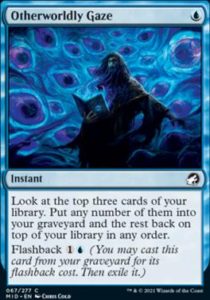
Unlike Tome Scour, the card is not that powerful on its own. Gaze should be considered more as a great support card, so our good turn two Reunion opening could happen more often. Flipping dredgers is a primary thing an enabler should do. And to be honest with you – Otherworldly Gaze is not the best at doing so. For a deck with twelve dredgers, the odds to find one is 54,5%. So much lower compared to Tome Scour for example. Still, it’s better than nothing. The true power of the card is in what else it can accomplish.
- It lets you keep good one landers. The most heartbreaking thing in Dredge was to see in the opening seven something like two Reunion effects, Imp, Thug, and only one land. This would be unkeepable. But with Gaze instead of one Reunion, it’s ok to use it as a scry 3 with an upside, to find a second land. It digs four cards deep (count with a draw step). Good one landers were keepable with Faithless Looting and Gaze digs one card deeper. Because of it, the range of playable hands has increased. It also let us go down from nineteen to eighteen lands.
- It can find a Reunion effect at the top three (the odds of seeing one are 42,8% if you play eight of them and haven’t got any in the hand already). It’s important in game one in goldfish scenarios, as well as post side when we are playing vs one-shot grave hate like Endurance.
- It can also find a sideboard card, so you can choose to naturally draw and react to something that’s problematic.
- It’s an instant – important with Gemstone Caverns in the sideboard and with other one mana reactive cards ready to be cast.
- It does ‘stuff’ from the graveyard. Maybe it’s not the best way to spend your two mana, but sometimes you don’t have anything better to do anyway. At least it can restore a broken dredge chain, or prolong it, for example, in a response to a Narcomoeba trigger, looking for Amalgam. It can be useful in post sideboard games when topdecking Reunion can give you a needed boost after an opponent’s graveyard hate happens.
Cathartic Reunion and Thrilling Discovery
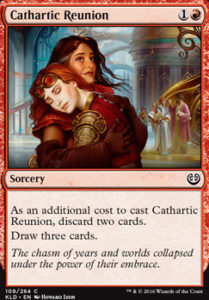
The majority of times, both cards will do the same: discard two and draw three cards. From Dredge’s perspective, it’s a potential for dredge fifteen. The longer our dredge chain is, the easier to get an overwhelming advantage early in the game. Try to max out the value of these effects. They are powerful, but only with a good setup. The ideal situation if before the action, there are two or more good dredgers in the graveyard (Imp and Thug counts, Darkblast should be counted as a support card). If not, So for instance, sometimes it’s better to spend a second turn on casting flashback of Otherworldly Gaze to get more looks for dredgers, than trying to go off from just a single Darkblast.
Which one is better, Reunion or Discovery? Let’s analyze that:
- Casting cost: Cathartic Reunion is better here because it doesn’t force you to grab a Sacred Foundry early in the game. It can be cast with Blood Moon in play, when the opponent had Spreading Seas, etc.
- Lifegain attached to Thrilling Discovery: It’s a minor addition and it helps you negate the life loss from our rainbow manabase. If you resolve two Discoveries on the same turn, they will turn on Ghouls.
- Discarding cards as a cost vs doing it on a resolve: it doesn’t matter in goldfish scenarios, but can be a huge difference when playing vs counterspells or soft grave hate. Both outcomes are useful and there isn’t one, the only solution to what should be cast first. If you are curious how to play with Reunions perfectly, check the gameplay section of the primer.
Merchant of the Vale
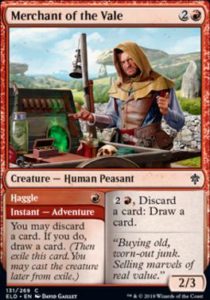
Personally, I’m not the biggest fan of this card. Its ceiling on turn one is what Tome Scour does all the time. It’s quite bad in heavy mulligan situations when you don’t have an access to the enabler + dredger sequence all the time. The 2/3 adventure guy rarely matters in the current Modern. The card’s only upsides are easier casting cost and that it can be played on the opponent’s turn, so it works nicely with Gemstone Caverns. That’s why it’s played in versions with four Caverns in the maindeck. I’m not a fan of them, so for me, there’s not any reason to play a worse version of the card.
Options from the past
Shriekhorn
In goldfish scenarios, it’s worse than Tome Scour on turn one and our curve later on is filled with two mana plays anyway. In interactive games, the flexibility of Otherworldly Gaze is more useful than just a raw flipping power. It’s a good enabler and one day maybe it will come back, but at the moment, other options are better.
Insolent Neonate
A card from the past. Similar to Merchant of the Vale, but can’t be cast at instant speed. Don’t play it now!
Burning Inquiry
Another card from the past. Since the discard is at random, it does not guarantee to bin a dredger. That’s why it shouldn’t be considered a turn one play. And after turn one, we want to go for Reunions. It was bad even in 2016, so imagine how bad would it be now?
Payoff
Milling cards is fun, but it’s easy to forget that we are doing it to set up the early pressure and overwhelm the opponent before they can do anything about it. What is used to finish the opponent?
Ox of Agonas

Payoff creature which also acts as an enabler that works from the graveyard. The fact that it combines both roles makes it the best option available for Dredge nowadays, even if we have to pay mana for recurring it and build the whole gameplan around it to make it happen. You can set it up as early as turn two, with the help of Tome Scour. Most often, it will be available for you on turn three and later on. And once you resolve it, you’ll most likely find a second one and be close to milling the entire library on turn four. If you have an option: escape Ox, or do something else, go for the 5/3. Don’t be afraid to eat your potentially useful stuff from the graveyard – you’ll most likely flip more of it from Ox’s trigger. I wouldn’t go for it only if the opponent represents Countermagic and Escaping it means that I would lose a lot of my payoff. Otherwise, just go for it. Don’t forget that you can hardcast Ox from hand! It can sometimes happen post side in slower match ups, especially when soft grave hate is involved.
Narcomoeba
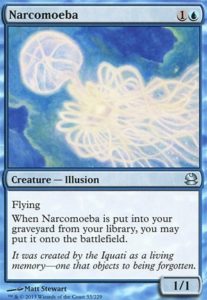
The Dredge staple from the beginning of the archetype’s existence. By itself, it’s quite bad. 1/1 flying isn’t spectacular, even if it’s for ‘free’. What’s more important, it’s an enabler for other powerful effects. In Modern Dredge, it’s the only way to return Prized Amalgam without any further restrictions. Remember that you can choose if you want to return Narcomoeba from the graveyard or not. Sometimes it’s worth not returning it. For example, having it in the graveyard can be more important to fuel Ox of Agonas and its Escape ability. Also, there are situations where you don’t want to trigger Prized Amalgam, for instance, you play around Ugin minus ability or vs Anger of the Gods and you have Silversmote Ghoul/another Amalgam triggered to return at your endstep, or fetchland + Bloodghast ready to return your 3/3s on the opponent’s endstep.
Prized Amalgam

It was the first big reason to play Dredge in Modern. After all these years, it’s still great. The whole deck is built in a way, so it’s relatively easy to return all flipped Amlagams by turn two or three. The timing of the return of Prized Amalgam is quite tricky – it returns at the beginning of the turn’s endstep. So if it gets triggered at your endstep (for example with Silversmote Ghoul), it won’t be able to return right away, because it will happen after ‘the beginning’ of the phase. Amalgam will wait for the next possible moment, which will be at the opponent’s end step. We can use this effect to play around sorcery speed mass removal like Supreme Verdict, Ugin, the Spirit Dragon or Anger of the Gods.
Remember that Amalgam’s ability does NOT have a ‘may’, so once triggered, it has to be returned to the battlefield.
Creeping Chill
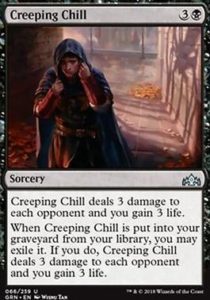
Another ‘free’ effect we get from Dredging. Great in tempo games, when hitting a couple of Lightning Helixes can win the game by itself. It’s also a crucial part of a Dredge burn plan when combat damage is not enough to close out the game on time. In my opinion, this card is a reason that keeps Dredge’s head above the surface. In current version of Dredge is even more important than in previous ones because it’s also used as a way to trigger one of our payoff creatures – Silversmote Ghoul.
Like Narcomoeba, its triggered ability is not mandatory, so you can choose to not use it. Useful when you need fuel for the Escape or the opponent has two Death’s Shadows and you don’t want them to be bigger.
Silversmote Ghoul
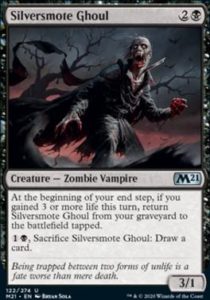
When combined with Creeping Chill, it’s able to return for zero mana and any other further restrictions. In longer chains, it acts as a Narcomoeba/Prized Amalgam hybrid – can both trigger our Zombie and if it’s not present, it’s a body on its own. Silversmote Ghoul got a lot of power when Dredge became more of an all-in strategy. More Reunions means longer dredge chains in early turns of the game, so it’s also easier to see Chill + Ghoul ‘combo’ at the same turn.
Ghoul returns on your end step, so if you want to try to flip it and Chill from Otherworldly Gaze, do it in your turn. Note that it’s not a ‘may’ ability. Simple – if you’ve gained life, it will return. The lifegain doesn’t have to be from the Creeping Chill. The opponent’s Solitude cast on your turn (but before the end step) that exiles our Amalgam or Ox will do the work too. The last pro tip: remember about Ghoul’s second ability! It’s good in tempo scenarios when we pressure the opponent with 3/1s and they have to waste removal spells to survive – extra Dredge action is always cool. You can also use it to find your last Creeping Chill to deal the last damage. Or sacrifice it if you’ve just flipped Creeping Chill, but you lack something that will trigger your Amalgams. Stay open minded.
Options from the past
Bloodghast
Another honorable mention in the primer. It used to be the best, but also the most skill-intensive payoff creature Dredge had, but the card lost a lot of its power with the ban of Faithless Looting. Nowadays, enablers cost more mana on average, so it’s harder to cast them before making the land drop. Maybe one day it will return to the deck.
Conflagrate
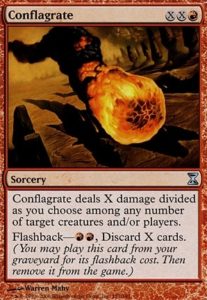
In Life from the Loam Dredge era, Conflagrate was like a swiss knife. It was a great removal spell, could act like a huge Fireball to finish the opponent, a discard outlet and even a removal for your own Bloodghasts, so they can be returned with a land drop, so you could trigger Prized Amalgams. But Modern has changed, and so as Dredge. Ox of Agonas and its ability to discard your whole hand is a huge nombo with Conflagrate. That’s why players (myself included) were trimming Conflags. Rainbow Dredge lists were playing a single copy, just to be able to win without combat – just with four Creeping Chills and a big Conflag shot. I even started playing without Conflagrate at all and to be honest, I don’t feel it’s needed anymore. The majority of games are decided on turns two and three – depending if we have Amalgams and Ghouls in play or not. There also aren’t that many decks that are trying to go wide with small creatures. They’re either playing X/1 guys like Ragavan (and they are usually kept in check with the help of Darkblast) or playing creatures that match up nicely against sorcery speed, and damage-based removal. Yawgmoth with Wall of Roots and Undying creatures, Violent Outburst into Crashing Footfalls, Sigarda’s Aid into attaching Hammer, etc. There’s also more lifegain attached to playable cards – Omnath, Locus of Creation and Solitude are the best example of that. In my opinion, there aren’t enough good reasons to keep playing Conflagrate. Still, the card is very powerful and flexible and I won’t be surprised if it will return to the maindeck one day.
The manabase
Dredge has quite ambitious mana requirements. It’s an aggro-combo deck, so every land has to enter the battlefield untapped. It’s basically a mono-red with three (or sometimes even four) splashes. All lands need to produce red, mostly because of RR in Ox of Agonas Escape. Playing only on two lands happens too often to have even a slight chance of not having the mana for that. Outside red, every other color is important. Blue is used for Otherworldly Gaze and Tome Scour. White is for Discoveries and sideboard options. Black to cast dredgers, most likely Darkblast and Imp, and discard spells post side. Green is the least important since it’s only sometimes used only for Ancient Grudge flashback.
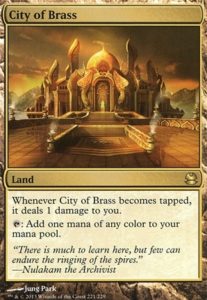
Fetch + shock manabase was a core of Dredge since the beggening of its existence. But the deck started to be so greedy on the mana, that going with traditional mana builds wasn’t doing enough. Every land must produce red mana. In terms of splashes: we need now Blue on turn one for our enablers, but also sometimes black if we want to cast Darkblast or discard spells from the sideboard, or white if Portable Hole is needed. There’s also a need to white on turn two, thanks to Thrilling Discovery. If you also take into account that you quite often work only on two lands, you’ll quickly find out that relying only on fetch + shock manabase won’t give you access to all colors on time. That’s why rainbow lands – City of Brass and Mana Confluence – were added. Having even one in the opening hand solves all mana problems. At first, this take was abused a bit too hard and a build of 12x rainbow (with four Gemstone Mines) + six fastlands was the most played one. To be honest, I was the one who popularized it. The main idea was to negate the life loss of rainbow painlands by adding fastlands to the mix. There were two problems though. The first one was Gemstone Mine. Having two of them in the opening was leading to feels bad moments when you were losing to sacrificing your own lands. It was also the easiest way to lose games against decks with counterspells – otherwise a very good matchup for us. The second problem was in mana sources of less needed colours. It was possible to build a manabase that would support blue mana nicely (twelve rainbow + three Spirebluff Canal), but black and white had to be ignored a bit in the process. And in some post sideboard games, for example white was more important because you had to resolve Portable Hole or Wear//Tear to answer the opponent’s hate card. That’s why I eventually switched back to eight rainbow lands and a mini package of fetches and shocks. The typical manabase looks like this:
4 Mana Confluence
4 City of Brass
6 red fetchlands
2 Steam Vents
1 Blood Crypt
1 Sacred Foundry
Blue red shockland was doubled because it’s better in one land keeps since it lets you cast Otherworldly Gaze to find a second land. In certain sideboard configurations with a lot of white spells, it can be possible that doubling Sacred Foundry instead of Steam Vents can be better. The line T1 Otherworldldy Gaze/Tome Scour into T2 Thrilling Discovery with two fetchlands in hand is also an argument in a discussion. In that case, with 2x UR and 1x RW, there’s a decent chance that after fetching blue, you can mill your only white source. With two Sacred Foundries, the odds of auto losing to one dredge action decreases significantly.
Gemstone Caverns in the maindeck – is it worth playing?
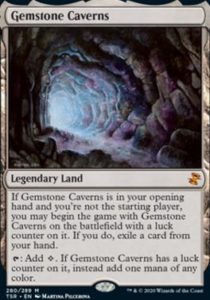
As you can see above, I presented the typical manabase without any Gemstone Caverns. There are Dredge players who would disagree with me. You can find decklists with four copies in the maindeck. The idea is to always go second, even if you win a dice roll. It gives you an additional card all the time while technically being on the ‘play’ a bit below 40% of the time, so it should also decrease the fail rate a bit. While it looks cool and you feel like a god when it works, I’m not a fan of this idea at all. In my opinion, being more often on the play is more important for the tempo deck than an extra card in hand. There are also other downsides, for example drawing two Gemstone Caverns as only two lands, finding it after you kept one lander with Otherworldly Gaze, etc. In my opinion, Gemstone Caverns is a really good sideboard option that comes in only if you are on a draw.
